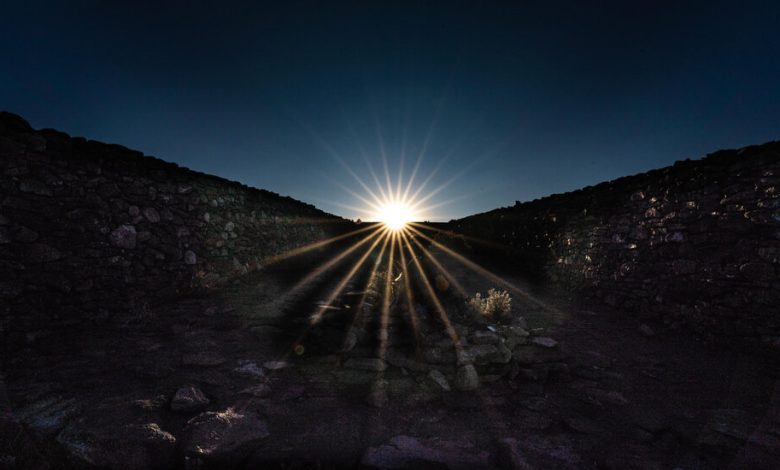An Ancient ‘Horizon Calendar’ Comes Into View Over Mexico City

Long before Europeans colonized North America, the Indigenous peoples in the valley where Mexico City would later arise may have followed a natural solar calendar that was so accurate it accounted for leap years.
The “horizon calendar,” proposed in a new study, relied on natural landmarks in the valley’s rugged eastern mountains, and was kept in sync with the astronomical year by a temple atop a sacred volcano. The system may have been used by the Aztec culture, which flourished in the area from roughly 1300 to 1500, though previous civilizations also referred to the horizon to tell time.
Earth’s trip around the sun isn’t divided into 365 perfectly discrete days. Every year, there is an extra quarter of a day. Failing to account for that time can add up, disrupting a civilization’s calendar. Tracking the days was a concern in the valley, known as the Basin of Mexico, where as many as three million people lived before Europeans arrived, making it among the most populated regions on the planet at the time. With so many mouths to feed, corn farmers had to time their planting precisely.
While the Mesoamerican peoples lacked compasses, quadrants or astrolabes, their method for keeping their agricultural calendar may have been hiding in plain sight around the basin, said Exequiel Ezcurra, a distinguished professor of ecology at the University of California, Riverside, and an author of the study, which was published on Monday in The Proceedings of the National Academy of Sciences.
“I’m not a historian, astronomer or an archaeologist,” Dr. Ezcurra said. “I’m a biologist, working on environmental sciences, so I came into this question a little bit haphazardly and with completely new eyes, I think, because I’m interested in the evolution of the main crops of Mesoamerica.”
Starting from this perspective, Dr. Ezcurra and his co-authors present a calendar model that matches the location of the sun on the horizon to festivities cited in Mesoamerican codices. Pre-Columbian skywatchers who followed these dawns from the same spot in the basin could track the sun with great accuracy, he said, because the slight differences in its position each day would be observable at such great distances.
The researchers also trekked up to the remains of a temple on Mount Tlaloc to watch the sun rise over an ancient causeway, which they believe may have been a celestial marker of the Mesoamerican new year that could have been used to make leap-year adjustments.
“This long stone causeway aligns with the sun exactly on Feb. 23, or Feb. 24, with a little variation from one year to the next, which is exactly the time in which the Aztec calendar started,” Dr. Ezcurra said.
That result, he said, is “exciting” because it “means that they were not only using observation points from the bottom of the basin against the mountains, but they were able to construct an observatory on the summit of the mountain that had the same alignments that they were getting from the bottom.”
The study offers a tantalizing vision of terrain-based timekeeping, but not all researchers agree with its conclusions. Ivan Sprajc, a specialist in Mesoamerican archaeoastronomy at the Slovenian Academy of Sciences and Arts, pointed to earlier research indicating that these eastern mountains were used to identify specific dates, rendering the team’s findings “not novel at all” in his view.
He added that the existing body of evidence strongly suggested that Aztecs, and their predecessors, never developed a correction system that incorporated leap years.
“My general opinion of this study is that it does not rely on compelling evidence and simply ignores a large amount of previous systematic research on Mesoamerican architectural alignments,” Dr. Sprajc said.
Not all experts were so scathing. Anthony Aveni, professor emeritus of astronomy, anthropology and Native American studies at Colgate University in Hamilton, N.Y., called the new work “a solid, well-documented contribution to Mesoamerican astronomy.”
“The alignments toward features on the eastern horizon in the Valley of Mexico, also involving Cerro Tlaloc, are well documented during the Aztec period, and here we have good evidence that these sorts of practice were in effect much earlier,” Dr. Aveni said, who reviewed the study for the journal that published it.
Dr. Ezcurra, for his part, said he had expected pushback from experts, given his unconventional expertise for this topic. Yet he hopes the new study raises more awareness of the natural wonders and rich heritage in the Basin of Mexico, where skywatchers have looked to the rising sun for centuries to orient themselves in space and time.
The basin’s mountains are “telling us stories of cultural evolution in the past that have become lost,” Dr. Ezcurra said.
